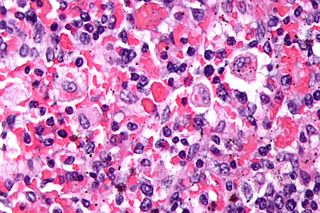Hemophagocytic lymphohistiocytosis pathophysiology
|
Hemophagocytic lymphohistiocytosis Microchapters |
|
Differentiating Hemophagocytic lymphohistiocytosis from other Diseases |
|---|
|
Diagnosis |
|
Treatment |
|
Case Studies |
|
Hemophagocytic lymphohistiocytosis pathophysiology On the Web |
|
American Roentgen Ray Society Images of Hemophagocytic lymphohistiocytosis pathophysiology |
|
Hemophagocytic lymphohistiocytosis pathophysiology in the news |
|
Directions to Hospitals Treating Hemophagocytic lymphohistiocytosis |
|
Risk calculators and risk factors for Hemophagocytic lymphohistiocytosis pathophysiology |
Editor-In-Chief: C. Michael Gibson, M.S., M.D. [1]
Overview
Pathophysiology
Excessive production of too many activated immune cells (lymphocytes) called T cells, natural killer cells, B cells, and macrophages (histiocytes) and cytokines by the immune system causes symptoms and damages liver and spleen and causes these organs to enlarge. Familial hemophagocytic lymphohistiocytosis also destroys blood-producing cells in the bone marrow, a process called hemophagocytosis. As a result, affected individuals have low numbers of red blood cells (anemia) and a reduction in the number of blood cells involved in clotting (platelets). A reduction in platelets may cause easy bruising and abnormal bleeding.
The brain may also be affected in familial hemophagocytic lymphohistiocytosis causing various symptoms and complications.
Secondary hemophagocytic lymphohistiocytosis is usually associated with infection by viruses, bacteria, fungi, or parasites or in association with lymphoma, autoimmune disease, or metabolic disease. Acquired HLH may have decreased, normal, or increased NK cell activity.
Microscopic Pathology
